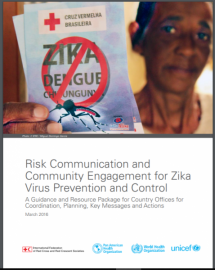Risk Communication and Community Engagement for Zika Virus Prevention and Control
The purpose of this document is to provide detailed guidance for the response strategies under the Strategic Response Framework (SRF). UN agencies, the International Federation of Red Cross and Red Crescent Societies (IFRC), INGOs, NGOs and CSOs can use the guidance to support the Government in the development and implementation of research driven, adaptable and context-driven risk communication and community engagement interventions.
These interventions are intended to help increase the understanding of the Zika virus and its potential consequences, prevent its spread, mitigate the impact on individuals and families, in particular women, and communities and contribute to on-going research to improve response activities and control efforts.
This document uses the best available scientific evidence, available at the time of its writing, on prevention and control of the Zika virus and its potential link to microcephaly and other neurological disorders2. The messages, actions and related supporting information will be revised periodically based on the epidemiology and evolution of the Zika virus outbreak, forms of transmission, and further information about Zika and its potential link to microcephaly and other neurological disorders. Updated versions will be circulated as needed.
This guidance operationalizes the risk communication and community engagement strategies outlined in the SRF by focusing on messages and behaviours for personal protection, for community-based vector control and for mitigating the impact on individuals and families.
Last modified: September 30, 2021
Language: English

